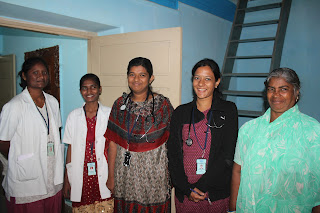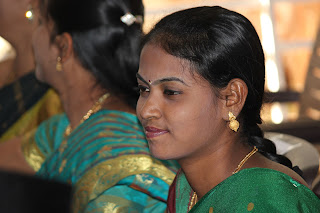As I have traveled around Bangalore many times the quotation from The Wizard of Oz, "Dorothy, we aren't in Kansas anymore" has come to my mind. Bangalore today is not the same city that we lived in more than 25 years ago. The population of is now 10 million. It is the fifth largest city in the country, exceeded only by Mumbai (Bombay), Delhi, Kolkota (Calcutta), and Chennai (Madras). Yet Bangalore is the fastest growing city in the country. They are known as the Silicon Valley of India with extensive development in the electronic and technological areas.
The first and major change noted from earlier years, is the dramatic increase in traffic. Automobiles, auto-rickshaws, and motorcycles fight for a place on the roads. Motorcycles have replaced the bicycles of earlier years.

On one trip through a urban area where we lived years ago, we got into this traffic jam and sat for 15 minutes waiting for one person to move so that other vehicles could begin to clear the tangle. As we sat numerous motorcycles threaded their way between vehicles at a cross street.
Buildings are more modern. Earlier they were stone, rough granite, or brick. Now one sees many buildings with large glass walls, or walls of polished granite.

Years ago, Commercial Street was the major place in the city to shop and purchase nice Indian or Western style goods. Commercial Street is still a vibrant shopping area with pedestrians and motorists fighting for the ride away on the narrow one way street.
Yet, modern malls have now been developed over the city. The one pictured below is four floors and contains a food court (where I had pizza for lunch) and Western brand electronic and clothing stores in addition to Indian craft shops.

In the area of this multi floor mall, I saw a jewelry store which was as elegant as any I have seen in the USA or any other large city around the world.
Even the smaller community of Hebbal, where the Bangalore Baptist Hospital is located, has its own mall within 100 yards of the hospital. Note the McDonald's sign out front of the mall.
Soon after our arrival in India in 1975 the Indian government asked the Coco-Cola Bottling Company to leave the country. At the same time they began prohibiting Western food chains from operating within the country. I saw signs for KFC, McDonald's, Subway, Pizza Hut, Chilies, and several other American food chains.
We left India in 1984 and the land line telephone system was still rudimentary. Now with the development of technology in the country, cell phones are used by almost all. Even the chief guest for the public hospital celebration, Justice N. Santosh Hegde, was interrupted during the reception by his cell phone.
Bangalore has experienced enormous changes within the past 30 years. It is a different city. However, as I went about the city I saw much that had not changed.......
The most beautiful and tasty vegetables can be right from merchants on the street....
Humans and animals may see see pulling their loads among the busy streets, usually now more in urban areas than rural areas........
The vast disparity between the wealthy and those in poverty remains great........
Indian food remains one of the most flavorful and tastiest (and I have enjoyed my fill during this visit).......
Indian women wear their elegant saris as one of the most beautiful of the world's dress......
And... the people of Bangalore as a whole are some of the most courteous, gentle, humble, and happy people I have know. My life has been greatly blessed by the relationships which I have made through the years in India. This visit has provided many opportunities to renew acquaintances with old friends and make new ones.
The first and major change noted from earlier years, is the dramatic increase in traffic. Automobiles, auto-rickshaws, and motorcycles fight for a place on the roads. Motorcycles have replaced the bicycles of earlier years.

On one trip through a urban area where we lived years ago, we got into this traffic jam and sat for 15 minutes waiting for one person to move so that other vehicles could begin to clear the tangle. As we sat numerous motorcycles threaded their way between vehicles at a cross street.
Multilevel buildings are seen everywhere. This apartment complex of 18 floors is located just behind the hospital on land which years ago was a quarry.
Buildings are more modern. Earlier they were stone, rough granite, or brick. Now one sees many buildings with large glass walls, or walls of polished granite.

Years ago, Commercial Street was the major place in the city to shop and purchase nice Indian or Western style goods. Commercial Street is still a vibrant shopping area with pedestrians and motorists fighting for the ride away on the narrow one way street.
Yet, modern malls have now been developed over the city. The one pictured below is four floors and contains a food court (where I had pizza for lunch) and Western brand electronic and clothing stores in addition to Indian craft shops.

In the area of this multi floor mall, I saw a jewelry store which was as elegant as any I have seen in the USA or any other large city around the world.
Even the smaller community of Hebbal, where the Bangalore Baptist Hospital is located, has its own mall within 100 yards of the hospital. Note the McDonald's sign out front of the mall.
Soon after our arrival in India in 1975 the Indian government asked the Coco-Cola Bottling Company to leave the country. At the same time they began prohibiting Western food chains from operating within the country. I saw signs for KFC, McDonald's, Subway, Pizza Hut, Chilies, and several other American food chains.
We left India in 1984 and the land line telephone system was still rudimentary. Now with the development of technology in the country, cell phones are used by almost all. Even the chief guest for the public hospital celebration, Justice N. Santosh Hegde, was interrupted during the reception by his cell phone.
Bangalore has experienced enormous changes within the past 30 years. It is a different city. However, as I went about the city I saw much that had not changed.......
The most beautiful and tasty vegetables can be right from merchants on the street....
The vast disparity between the wealthy and those in poverty remains great........
Indian food remains one of the most flavorful and tastiest (and I have enjoyed my fill during this visit).......
Indian women wear their elegant saris as one of the most beautiful of the world's dress......
And... the people of Bangalore as a whole are some of the most courteous, gentle, humble, and happy people I have know. My life has been greatly blessed by the relationships which I have made through the years in India. This visit has provided many opportunities to renew acquaintances with old friends and make new ones.














































